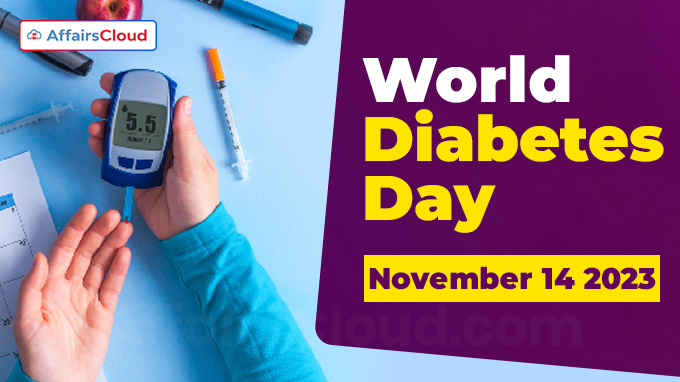 The United Nations (UN)’s World Diabetes Day (WDD) is annually observed across the globe on 14 November to raise awareness about the impact of diabetes on the health of people.
The United Nations (UN)’s World Diabetes Day (WDD) is annually observed across the globe on 14 November to raise awareness about the impact of diabetes on the health of people.
- WDD also aims to highlight the opportunities to strengthen the prevention, diagnosis, and treatment of diabetes.
WDD Campaign:
i.WDD is the world’s largest diabetes awareness campaign, annually focusing on a dedicated theme that runs for one or more years.
ii.The theme for WDD 2021-23 is “Access to Diabetes Care“.
- The campaign focuses on the critical need to understand the risk of type 2 diabetes to help delay or prevent the condition.
iii.The slogan for the 2023 campaign is: “Know your risk, Know your response.”
Background:
i.WDD was created in 1991 by the International Diabetes Federation (IDF) and the World Health Organization (WHO) to address the growing concerns about the health threat posed by diabetes.
- Since 1991, WDD has been observed on 14 November at the global level by IDF.
ii.On 20 December 2006, the United Nations General Assembly (UNGA) adopted the resolution A/RES/61/225 and proclaimed the 14 November of every year, as a UN Day, beginning in 2007.
iii.The first-ever UN-recognised WDD was observed on 14 November 2007.
Why November 14?
14 November marks the birthday of Sir Frederick Grant Banting, a Canadian medical scientist who co-discovered insulin along with Charles Herbert Best, an American-Canadian medical scientist in 1922.
- Sir Frederick Grant Banting won the Nobel Prize in Physiology or Medicine in 1923 for the discovery of insulin, he shared the award with John James Rickard Macleod, a Scottish physiologist.
WDD Logo:
i.The WDD campaign is represented by the blue circle logo.
ii.IDF introduced the blue circle as the universal symbol of diabetes in 2006, for a campaign that resulted in the passage of a UN resolution on WDD.
iii.The logo signifies the unity of the global diabetes community in response to the diabetes epidemic.
Note: In 2023, IDF incorporated the blue circle into its official hummingbird logo.
Diabetes and its types:
i.It is a chronic disease, which occurs when the pancreas does not produce enough insulin, or when the body cannot effectively use the insulin it produces.
- This leads to an increased concentration of glucose in the blood (hyperglycemia) and is a major cause of blindness, kidney failure, heart attacks, stroke and lower limb amputation.
ii.Type 1 diabetes (previously known as insulin-dependent or childhood-onset diabetes) is characterized by a lack of insulin production.
iii.Type 2 diabetes (formerly called non-insulin-dependent or adult-onset diabetes) is caused by the body’s ineffective use of insulin.
- It often results from excess body weight and physical inactivity.
iii.Gestational diabetes is hyperglycemia that is first recognised during pregnancy.
Key Facts:
According to WHO:
- Globally, around 422 million people have diabetes, and 1.5 million deaths are directly attributed to diabetes every year.
- Over 90% have type 2 diabetes. Close to half are not yet diagnosed.
- Only about 50% of people with type 2 diabetes get the insulin they need, often because their country’s health systems cannot afford it.
- Quitting smoking reduces the risk of developing type 2 diabetes by 30-40%.
- In the WHO South-East Asia (SEA) Region, India has placed more than 24 million people with hypertension and diabetes on standard care.
About International Diabetes Federation (IDF):
President– Prof. Akhtar Hussain (Norway)
President-Elect– Prof Peter Schwarz (Germany)
Headquarters– Brussels, Belgium
Founded on– September 23, 1950



